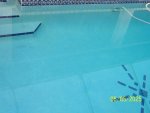In an older (15 or so years) surface we seem to have algae growth on the pool surface regardless of FC/TC content. In addition, it appears in vertical striations that are not consistent with eddies or "dead spots" in pool circulation. I brush the pool every day, vac in the evening.
They do appear and reappear in regular areas of the pool. Mostly mustard algae it seems (yellow) although some are darker.
Two questions come to mind:
1) At mustard algae shock value for a given CYA level how long should it take for minor, and I mean MINOR, surface mustard algae to be killed? Days? Weeks?
2) Water is sparkling clear yet this algae will appear on pool surface ONE DAY after shock value is reduced to target. Sometimes even ABOVE target value.
Thoughts?
They do appear and reappear in regular areas of the pool. Mostly mustard algae it seems (yellow) although some are darker.
Two questions come to mind:
1) At mustard algae shock value for a given CYA level how long should it take for minor, and I mean MINOR, surface mustard algae to be killed? Days? Weeks?
2) Water is sparkling clear yet this algae will appear on pool surface ONE DAY after shock value is reduced to target. Sometimes even ABOVE target value.
Thoughts?



